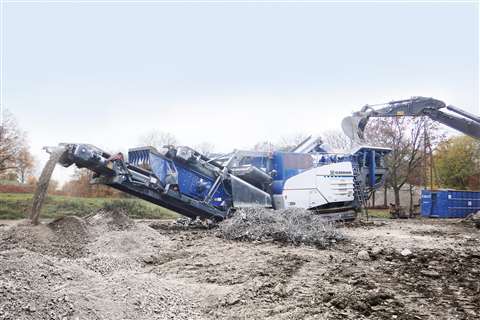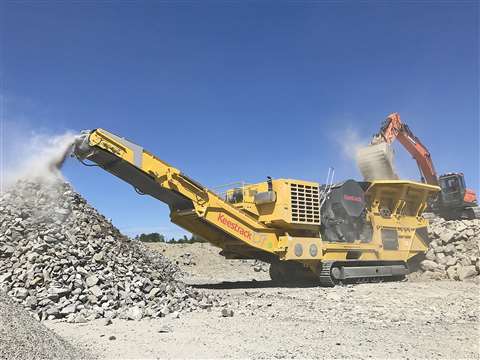Crushing and screening – the next stage
24 June 2019
A new year brings with it fresh optimism and innovation – not to mention a whole host of trade shows – giving crusher and screens manufacturers the opportunity to impress once more.
That was the case for Germany-based company Kleemann, which has launched two new mobile impact crushers that are said to be high performers for demolition concrete and asphalt pavement recycling, and natural stone processing.
Kleeman MR130 Zi EVO2 mobile impact crusher

Step forward the Mobirex MR 110 Zi EVO2 and MR 130 Zi EVO2, which were showcased for the first time at World of Concrete this year. The key to these new models, at least in name, is the ‘EVO2’ part. The Mobirex EVO2 series is used in the primary and secondary crushing stages and boasts a new Spective control system.
The models have been designed to be easily transported and are ready for rapid deployment. They have a diesel-direct drive concept which ensures high performance with economical consumption at the same time, according to the company.
The innovative Continuous Feed System (CFS) is said to control the frequency of the conveyor belts in relation to the crusher load. The plant is controlled via a 300 mm (12 in) touch panel incorporating the Spective control concept.
Spective simplifies the operation of the plant ensuring all functions are recognisable. This way, operating errors are avoided and occupational safety is improved.
Important functions, such as the crusher gap adjustment, are easily adapted, some even during operation of the plant.
Another smart feature of the crushers is the integrated, independently vibrating double-deck prescreen, which reliably filters fines and keeps them out of the crusher, cutting wear while saving fuel. The plant can also be equipped with an extra-large secondary screening unit to produce high volumes of a defined final particle size without the addition of a classifying screen.
A company the size of Keestrack has lots of experience in launching new products, and this year has seen it present a new model in the compact crushing sector. Bauma was the launchpad, and the B7e was debuted internationally as a new 700 t/hr model, replacing the smaller B6.
Keestrack B7e impact crusher
The plant’s core is the tried and tested single-jaw, CJ 412 jaw crusher with a 1,200 x 830 mm (47 x 32 in) inlet for feeding sizes up to 700 mm (27 in) and a wide, hydraulically adjustable CSS range of 75 to 250 mm (3 to 9 in). In the B7e – only available as a plug-in hybrid – the crusher is driven by a 132 kW electric motor.
Another 55 kW electric motor powers the hydraulic system for the tracks, the lifting cylinders, the vibrating feeder with two-deck pre-screening and all conveyors.
The entire diesel-electric power is delivered by a Volvo diesel 285 kW engine and a 330 kVA generator.

According to Keestrack, energy-saving costs of up to 80% can be achieved in emission-free plug-in operation from mains or external gensets. The plant weighs just under 69 t and is highly mobile.
The company also showcased its recently-launched model, the fully-hybrid impact crusher R3e with single-deck post-screen and oversize recirculation. This model is said to be particularly interesting to companies looking for lighter-weight models.
Terex J-1160 jaw crusher
Terex Finlay has launched its second-generation J-1160 jaw crusher, said to have had the customer and operator at the forefront of its functionality.
In comparison to its predecessor, the plant has a number of improvements such as increased under jaw clearance and all-round preventative maintenance and serviceability access.
The heartbeat of the machine, says Terex, is the aggressive 1,000 x 600 mm (39 x 23 in) jaw crusher with a proven pedigree in recycling, demolition and aggregate production applications. The hydrostatic drive gives the operator the flexibility of variable crushing speed and the ability to run the chamber in reverse in recycling applications.
According to Terex, the machine is designed for maximum fuel efficiency delivering one of the lowest costs per tonne in the market. It also features its updated and larger heavy-duty variable speed vibrating grizzly feeder with integrated prescreen. This increased screening area and aggressive action is said to provide a more efficient method of separating and removing fines before entering the crushing chamber.
The variable speed VGF (vibrating grizzly feeder) ensures continuous choke feeding of the crushing chamber, and material from the prescreen can be diverted to a stockpile via the on-board by-pass conveyor or join the crushed product on the main belt.
It features a large, 5 cu m (176 cu ft) hopper with fixed sides as standard and is also available with hopper extensions fitted with hydraulic self-locking to provide efficient and faster machine set up and tear down times.
A key new design feature of the machine, according to the company, is the 900 mm (35 in) wide main conveyor which can be raised and lowered allowing the operator to perform maintenance functions from ground level and for ease of removal in clearing blockages.
The machine is fitted with the Terex Finlay T-Link telematics system as standard.
Sandvik QJ241 mobile jaw crusher
Revelling in its most compact machine in the series, Finnish company Sandvik has launched the QJ241 mobile jaw crusher said to be ideal for smaller operations. Like the rest of the range, the model promises maximum productivity with low operating costs, and has been designed with the user in mind.
The model uses a substantial 1,000 x 650 mm (39 x 25 in) jaw, powered by a 168 kW engine. This means that while the machine is compact, it retains a high level of power and productivity. The jaw itself is adjustable, allowing the operator to ensure output is always at its optimum level.
This mobile jaw crusher is also said to be the ideal solution for recycling sites, yet is equally productive for a number of other applications. The crusher also provides a greater discharge height and increased clearance for rebar discharge, due to the raise and lower facility on the main conveyor.
The hydraulically adjustable jaw setting can be tailored to customer applications and the reversible crushing action can relieve blockages and deal with problematic materials. The equipment also features hydraulically folding doors on the reinforced hopper for quick set up times, maintaining optimum productivity at all times.
Maintenance has also been improved thanks to new design features such as steel pipework, enabling a safe and maintenance-free sealing solution with the added benefit of better heat dissipation. With easy access to the engine compartment and an in-built automatic central lubrication system, downtime is reduced.
This article is taken from the May-June 2019 issue of Demolition & Recycling International. To see the full article, including additional images, or to register to receive the magazine on a regular basis, please visit www.khl.com/subscriptions




